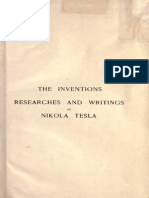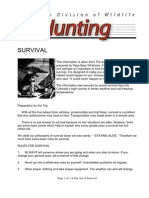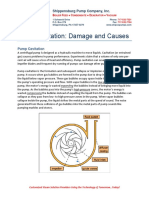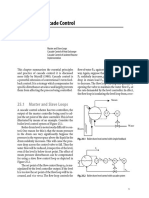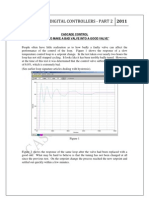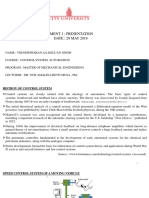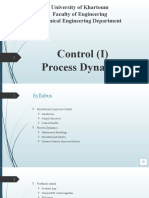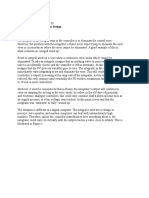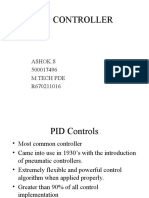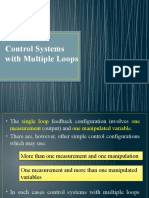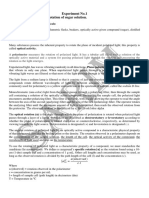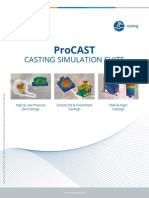Ball Lightining Teslas Production of Electric Fireballs PDF
Ball Lightining Teslas Production of Electric Fireballs PDF
Uploaded by
FreakbizarroCopyright:
Available Formats
Ball Lightining Teslas Production of Electric Fireballs PDF
Ball Lightining Teslas Production of Electric Fireballs PDF
Uploaded by
FreakbizarroOriginal Title
Copyright
Available Formats
Share this document
Did you find this document useful?
Is this content inappropriate?
Copyright:
Available Formats
Ball Lightining Teslas Production of Electric Fireballs PDF
Ball Lightining Teslas Production of Electric Fireballs PDF
Uploaded by
FreakbizarroCopyright:
Available Formats
(Extract from TCBA NEWS, volume 8, #3, 1989) TESLA'S PRODUCTION OF ELECTRIC FIREBALLS by Kenneth L.
Corum and James F. Corum Corum & Associates, Inc. 8551 State Troute 534 Windsor, Ohio 44099 "I have succeeded in determining the mode of their formation and producing them artificially." Nikola Tesla [ELECTRICAL WORLD AND ENGINEER, March 5, 1904] INTRODUCTION Although there have been numerous articles, publications, and seminars on the phenomenon of ball lightning and fireballs, only a very few have ever reported on the actual production of fireballs. Yet even fewer of these handful have ever actually produced fireballs under conditions that, even remotely, could be considered similar to nature. As with General Relativity, the number of theoretical publications exceeds the number of experimental papers by several orders of magnitude. Our laboratory in Ohio (which is noted for slow wave helical antenna research) has developed equipment that will produce electric fireballs that will last after the external power is removed. We have been able to produce electric fireballs that will fit the conditions and circumstances that are frequently seen in nature (i.e., fireballs passing though windows, inside airplanes, traveling along fences, etc.). Last summer, during the 3rd International Tesla Symposium at Colorado Springs, while walking around Tesla's Laboratory site and Prospect Lake in nearby Memorial Park, Leland Anderson made the comment, "I don't understand why we don't all see fireballs. The way Tesla described them, they just seemed to bubble from his machine." (See Photograph 4). We had been discussing the "missing" chapter 34 that Harry Goldman had just published in TCBA NEWS (Volume 7, #3, 1988 pp. 13-15). Its import may be gotten form this brief quote attributed to Tesla: "...it became apparent that the fireballs resulted form the interaction of two frequencies, a stray higher frequency wave imposed on the lower frequency oscillations of the main circuit.... This condition acts as a trigger which may cause the total energy of the powerful longer wave to be discharged in a infinitesimally small interval of time and the proportionately tremendously great rate of energy movement which cannot confine itself to the metal circuit and is released into surrounding space with inconceivable violence. It is but a step, from the learning how a high frequency current can explosively discharge a lower frequency current, to using the principle to design a system in which these explosions can be produced by intent." -N. Tesla It was a puzzle to us. While flying back to Cleveland, we continued to compare Chapter 34 with the photographs in Tesla's published notes. And then it struck us. We just weren't using the circuit configuration which Tesla shows to us. When we got back, we arranged our apparatus as shown in Figure 1.
figure 1.
APPARATUS Following Tesla's instructions, we rewired our apparatus as two synchronously pulsed high power RF oscillators, the first at a frequency of 67 KHz and the second at 156 KHz (The exact frequencies aren't critical). The basis for the apparatus was first conceived and patented in 1897 by Nikola Tesla. The idea of using two oscillators in synchronism was also used by Tesla at the turn of the century in a patented primitive spread spectrum communication system. The apparatus can be seen in dozens of photographs and circuit diagrams in Tesla's Colorado Springs Notes (referred to as CSN below). There have been many descriptions and analyses of Tesla's oscillators. The classic being the Oberbeck in 1895. However, all of these scientific and engineering descriptions fall short of a true description. It wasn't until we applied slow wave transmission line theory and partial coherence to Tesla's oscillator that we were able to accurately predict the operation of the oscillator and the subsequent production of fireballs. The apparatus consists primarily of two one-quarter wavelength, slow wave helical resonators above a conducting ground plane. Both of the resonators were magnetically coupled by a common link to a spark gap oscillator, of high peak power (approximately 70 KW), operating at a frequency of 67 KHz. The actual average power being delivered to the high voltage electrode was on the order of 3.2 KW (2.4 megavolts RF). Tesla, of course, was running about 100 items the power which we could produce with our rather modest equipment. OPERATION The spark gap oscillator was set to 800 pulses per second and the duration was 100 microseconds. The low frequency coil had a coherence time of 72 microseconds. This means that the induced incoherent oscillations on the resonator took 72 microseconds to build up a standing wave (or interference pattern), and show up as a high voltage on the top end of the resonator: Vmax = S V min (where S is the VSWR) [The theory is developed in great detail in References 5,6,7. Reference 8 even provides a computer assisted tutorial.] The high frequency coil had a coherence time of 30
microseconds. #1. Using the high frequency coil to arc to the low frequency coil, the low frequency coil would then release its energy rapidly, in a burst. The burst of energy released manifests itself in the shape of a ball or "bubble." Due to the faster voltage rise on the high frequency coil and the subsequent short duration arc to the low frequency coil, the low frequency now sees a a low impedance where it would normally see a high impedance. the energy trapped in the coil when the oscillator was on must now be dissipated very quickly at this lower impedance point, hence the burst. (See CSN page 114, bottom paragraph. Tesla's use of lumped circuit Q is somewhat misleading, but his physics is substantially correct. Circuit 4 on page 115 and the one on the top of page 174 are virtually the same as Figure 1.) #2. A second method of fireball production includes the use of microscopic vaporized metal or carbon particles. We used the low frequency coil alone and deposited a thin film of carbon particles on the high voltage electrode. When the voltage began to rise on the end of the resonator, streamers began to form on the electrode. The current passing through the carbon film tended to rapidly heat the carbon particles. This dissipation of power also tends to quickly reduce the impedance and subsequently release all the power rapidly into this heated micron size "resistor." The same results may be gotten by using "the tip of rubber covered cable or sire #10" to "facilitate the pumping of the spark." (CSN page 173-174) Old fashioned rubber is loaded with soot. Experimentally, we have determined the ideal set of conditions for producing electric fireballs. They are: 1. Generate a lot of carbon or vaporized metal particles in a small region of space. 2. Create large electric fields in the same vicinity (on the order of 1 to 2 MV/m). 3. Rapidly elevate the temperature of the particles. Video tape easily documents the results of meeting these three conditions. From this, fireball lifetimes are deduced to be 1 to 2 seconds and dimensions are 1 to 3 centimeters in diameter. Also, these are in agreement with Tesla's observations and conclusions. For example, in one place he attributes fireballs to the presence of resistively heated material in the air. (CSN page 333) This mechanism is consistent with Zaitsev's relatively recent theory in which the resistive heating of particles creates a glowing region or fire ball: "the current of the preleader stages of the discharge from the seed [cloud of fine particles (metal, soot, or ash)] flowing through the structure drives it to thermal explosion." (ref. 1) The fire balls disappear either when the particles burn up or when a thermal explosion occurs. we have observed both. RESULTS Using these methods for producing the fireballs, we then set about creating conditions as described by observers of ball lightning. By having the streamers, produced by the two resonators operating together, strike a windowpane surrounded by a wooden frame, we produced conditions normally found in nature. (see refs 2 &3) What was observed by the operator of our apparatus was astounding! "the streamers went from the high voltage terminal and struck the windowpane. There were many fire balls present between the electrode and the window. But where the streamers hit the glass, there were many fireballs emanating from the opposite side of the glass. The fireballs would then travel slowly horizontally 12 inches or so and flare up. Some would travel out a bit farther and explode." What was captured on video tape can be seen in the sequence of photos 1, 2, and 3. These results are reproducible on demand. Try it! Powell and Finkelstein have described a mechanism for how fire balls may appear to pass through a glass window intact.
"initially electric lines of force pass freely through glass. Positive ions from the ball follow force lines and pile up on one side of the glass while electrons from the room accumulate on the other. When the ball approaches, the glass is heated or broken down enough to become slightly conducting. It then becomes an electrode, and a ball is formed inside the room; the ball then floats away from the window." (Ref. 3) The actual physics may be somewhat different, but the sequence of photographs 1, 2, and 3 support the general idea. The relative ease of electric fireball generation by high voltage discharges in the presence of carbon films, smoke, ash, and dust is consistent with its frequent natural observation in and around chimneys, where carbon is deposited in great profusion. [Readers familiar with Michael Faraday's famous Christmas Lecture, "The Chemical history of a Candle" ("There is not a law under which any part of this universe is governed which does not come into play."), will recall his glowing remarks about the presence of smoke and solid carbon particles in a brilliant candle flame - they give us glorious colors and beautiful light. Imagine what would have resulted if Faraday and Tesla had met! If you can't get the 1 or 2 MV that Zaitsev requires as necessary and which we observed under condition 2 above, you can place a wire wrapped plumber's candle on the side of your small Tesla coil and get an idea of what can be seen on a larger machine. Again, video taping the experiment, adjusting the power levels and reviewing the tape, frame by frame, will be quite a revealing experience. Faraday noted that if you put a strainer or a glass tube down in a candle flame, you will see an incredible amount of soot particles bubbling up. This is what gives candle flame is color and luminosity.] we were able to produce other interesting features. Often we had pulsating fireballs. These would appear and then shrink. When they were hit by streamers, they would grow in size then shrink again. This would occur a number of times and then they would fade away. Another feature was that some had the appearance of a doughnut; bright circles with darkened centers. Others appeared to the observer as white, red, green, yellow, blue-white, and purple. See photo 4. Many other color photographs and a historical discussion are given in Reference 9. CONCLUSION We believe the phenomenon that manifests itself when the coherence time is cut short could indeed be the same phenomenon that occurs in nature. Instead of having a short helical resonator being the transmission line, the natural lightning stroke could be a full quarter-wave transmission line with its own coherence time shortened by small streamers at one end of the lightning stroke. According to lightning specialists, most of these small streamers occur at the top end of the lightning stroke. This would account for the infrequency of ball lightning on the ground side of the stroke. Dust, soot, ashes, and other pollutants in the air near lightning strikes would, or course, produce similar results.
Our conclusion is that these fireballs are primarily RF in origin, and not nuclear phenomena. Consistent with Tesla's observations, they can be produced either by high current dump into hot air ["I am satisfied that the phenomenon of the fireball is produced by the sudden heating, to a high incandescence of a mass of air or other gas as the case may be, by the passage of a powerful discharge." CSN page 368] or by the presence of resistively heated material particles ["I attribute them (fire balls) to the presence of material in the air at that particular spot which is of such nature, that when heated, it increases the luminosity." CSN page 333] The latter would account for the "engine room fire balls' produced by high current switches and relays. Finkelstein and Rubenstein once made a remarkable statement: "If this model is appropriate, then ball lightning has no relevance to controlled-fusion plasma research." (Ref. 4) If should now be apparent that this position can be experimentally supported. In our literature research on the topic over the past 26 years, we have read through hundreds of technical articles, papers, reports, and books. It would be impossible to cite and discuss all of them in this communication. But we believe that Tesla's is the only apparatus that has been developed that can address and reproduce on demand the many descriptions of ball lightning in nature. Now a host of experimenters may carry out fire ball generation and experimentation under their own controlled conditions. Best of all, the required apparatus is not only inexpensive, it is readily available in thousands of homes and existing laboratories around the world. What would have transpired if Faraday and Tesla had met? Why, high power RF oscillators and candle chemistry would have combined to reign brilliant electric fireballs - of course! REFERENCES 1. "New theory of ball lightning" by A.V Zaitsev, Soviet Physics-Technical Physics, Vol. 17, #1, July, 1972, pp. 173-175. 2. Ball lightning and Bead Lightning, by J.D. Barry, Plenum Press, 1980, pp 114-115. 3. "Ball lightning," by JR Powell and D. Finkelstein, American Scientist, Vol. 58, 1970, pp 262-280, See page 279. 4. ""Ball Lightning," by D. Finkelstein and J. Rubenstein, Physical Review, Vol 135, #2A, July 20, 1964, pp A390A396. 5. "A Technical Analysis of the Extra Coil as a Slow Wave Helical Resonator," with Kenneth L. Corum, Proceedings of the 2nd International Tesla Symposium, Colorado Springs, Colorado, 1986, chapter 2, pp 1-24. 6. "The Application of Transmission Line Resonators to High Voltage RF Power Processing: History, Analysis, and Experiment. 7. Vacuum Tube Tesla Coils, by J.F. Corum and K.L. Corum, Published by Corum & Associates, Inc., 1988, [100 page text, $55] 8. TCTUTOR - A personal Computer Analysis of Spark Gap Tesla Coils, BY J.F. Corum, D.J. Edwards, and L.L. Corum, Published by Corum & Associates, Inc., 1988, [110 page text & disk, $75] 9. Fire Balls - A Collection of Laboratory Experiment Photographs, (text plus 36 photographs and commentary), by K.L. Corum, J.D. Edwards, and J.F. Corum, Published by Corum & Associates, Inc., 1988, [50 pages, $55]. 10. The Chemical History of a Candle, by Michael Faraday, (last given in 1860), transcribed by Sir William Crookes, Edited by W.R. Fielding, E.P. Dutton & Co., 1920, pp. 52-58 11. Colorado Springs Notes, by Nikola Tesla, edited by Aleksander Marincic, Nolit, Beograd, Yugoslavia, 1978, pp.111, 330-333, 368-370, 372, 379-384, 431-433, (CSN above)
You might also like
- Russian Secret Alien Races Book PDFDocument93 pagesRussian Secret Alien Races Book PDFFreakbizarro91% (23)
- Nikola Tesla - The Inventions, Researches and Writings of Nikola TeslaDocument509 pagesNikola Tesla - The Inventions, Researches and Writings of Nikola Teslajrod100% (37)
- The Voynich ManuscriptDocument209 pagesThe Voynich ManuscriptPixelate95% (38)
- Oil Storage Tanks - John RinneDocument8 pagesOil Storage Tanks - John RinnePatricio100% (1)
- DykeDocument11 pagesDykeAws EmamNo ratings yet
- Art of SurvivalDocument14 pagesArt of SurvivalFreakbizarroNo ratings yet
- Wages - Grounding and BondingDocument20 pagesWages - Grounding and BondingLimuel EspirituNo ratings yet
- Cascade Control Signal Distribution BlockDocument4 pagesCascade Control Signal Distribution BlockFelipeNo ratings yet
- Workshop#10 Report - Cascade Control of Jacketed Reactor - Roy - StewartDocument14 pagesWorkshop#10 Report - Cascade Control of Jacketed Reactor - Roy - Stewartdevbones18No ratings yet
- Separation Process in Oil and Gas - Part-2 by Anand PatelDocument10 pagesSeparation Process in Oil and Gas - Part-2 by Anand PatelAbderrahmane AbderrahmaniNo ratings yet
- Seperators PresentationDocument20 pagesSeperators PresentationAhmed JafferNo ratings yet
- Manipulated Variable: Cascade ControlDocument2 pagesManipulated Variable: Cascade ControlAbu SyakirahNo ratings yet
- Control Loops 2Document22 pagesControl Loops 2Muntadher AbbasNo ratings yet
- Pump Cavitation - Damages and CausesDocument3 pagesPump Cavitation - Damages and CausesWilliam MaNo ratings yet
- Traditional Advanced Control StrategiesDocument48 pagesTraditional Advanced Control Strategiescape iipeNo ratings yet
- Plant Location and Lay-OutDocument26 pagesPlant Location and Lay-OutJoy Maan De GuzmanNo ratings yet
- Foam Dam Brochure REV 0 1210Document2 pagesFoam Dam Brochure REV 0 1210Ildegar PuertaNo ratings yet
- Plant Location and LayoutDocument11 pagesPlant Location and Layoutashutosh0% (1)
- Lecture 10 - Multiple Control Loops - 2023Document26 pagesLecture 10 - Multiple Control Loops - 2023Mohamed SalaheldinNo ratings yet
- Cascade Control: 25.1 Master and Slave LoopsDocument10 pagesCascade Control: 25.1 Master and Slave Loopsdeepak pandeyNo ratings yet
- Cascade LoopDocument6 pagesCascade LoopAhmed EldosokyNo ratings yet
- Control System PresentationDocument10 pagesControl System PresentationVikneshwaran Keluan SinghNo ratings yet
- Temperature Control ApplicationDocument22 pagesTemperature Control Applicationsyafiq izzuddin bin sapriNo ratings yet
- Override and Selective ControlDocument16 pagesOverride and Selective ControlPrasef Karl Andres Cortes IIINo ratings yet
- Industrial Process DesignDocument44 pagesIndustrial Process DesigntruchitoNo ratings yet
- Cascade Control 1Document4 pagesCascade Control 1Didik RiswantoNo ratings yet
- Bonding and Grounding of Flammable Liquids 2002 PDFDocument3 pagesBonding and Grounding of Flammable Liquids 2002 PDFAnonymous wtK1AZBiNo ratings yet
- Revolift SP - ExterranDocument5 pagesRevolift SP - ExterranHamidReza AhadiyanNo ratings yet
- Control PanelsDocument40 pagesControl PanelsMYSTERIOOOOUSNo ratings yet
- Control Loop CharacteristicsDocument10 pagesControl Loop CharacteristicsJohn Russell MoralesNo ratings yet
- Cascade ControlDocument13 pagesCascade ControlJoshua JayasuriyaNo ratings yet
- Process Control - Instrumentation and Control Engineering Interview QuestionsDocument11 pagesProcess Control - Instrumentation and Control Engineering Interview QuestionsIffatNo ratings yet
- Types of Separators - 12eleven Production Equipment v052020Document28 pagesTypes of Separators - 12eleven Production Equipment v052020Hamza MughalNo ratings yet
- L-01 Introductory ConceptsDocument17 pagesL-01 Introductory ConceptsGAYTRI SACHDEVANo ratings yet
- Cascade Control System 1Document20 pagesCascade Control System 1IffatNo ratings yet
- LL - English - Farsi GlossaryDocument20 pagesLL - English - Farsi GlossaryPiano AquieuNo ratings yet
- 4 Grounding SystemDocument10 pages4 Grounding SystemAhmed ElsayedNo ratings yet
- Process Control Chap 9 Cascade ControlDocument20 pagesProcess Control Chap 9 Cascade ControlAishah RashiddiNo ratings yet
- Hazardous Area EquipmentDocument28 pagesHazardous Area Equipmentnavi_0403No ratings yet
- Biochemical Engineering B.SC, University of DebrecenDocument6 pagesBiochemical Engineering B.SC, University of DebrecenArifuzzamanNo ratings yet
- 1.introduction To Process Control 1Document46 pages1.introduction To Process Control 1Husna ElatabaniNo ratings yet
- ControlDocument43 pagesControlaramNo ratings yet
- PIDs Best Practices PDFDocument80 pagesPIDs Best Practices PDFmawooaNo ratings yet
- Types of Air CompressorsDocument2 pagesTypes of Air CompressorsSrinivas GoudNo ratings yet
- Lecture-2 Introduction To Process Control Part 2Document25 pagesLecture-2 Introduction To Process Control Part 2HATAM TALAL ALINo ratings yet
- Facility PlanningDocument49 pagesFacility Planninggazala100% (5)
- Chapter 2-1Document22 pagesChapter 2-1Fathi ShokryNo ratings yet
- Controlled Variable Manipulated Variable Controlle R Type /scheme Gproms Model/Process NameDocument5 pagesControlled Variable Manipulated Variable Controlle R Type /scheme Gproms Model/Process NameJoseph OrjiNo ratings yet
- Control Loop Case 1Document5 pagesControl Loop Case 1tatasrba100% (1)
- Control Loop Performance Analysis Over Networked Control SystemsDocument0 pagesControl Loop Performance Analysis Over Networked Control Systemsgravity_engNo ratings yet
- Rules and Rules of Thumb For Duct SystemsDocument1 pageRules and Rules of Thumb For Duct SystemsNguyễn Xuân ĐiệpNo ratings yet
- 13 Cascade ControlDocument39 pages13 Cascade ControlMansour AbdulazizNo ratings yet
- Portable Fuel Tanks Bonding and Grounding PDFDocument3 pagesPortable Fuel Tanks Bonding and Grounding PDFSmart LauNo ratings yet
- Pid Controller: Ashok.S 500017496 M.Tech Pde R670211016Document40 pagesPid Controller: Ashok.S 500017496 M.Tech Pde R670211016Ashik Jacob Oommen100% (1)
- Cascade ControlDocument38 pagesCascade ControlSun Lwin100% (1)
- Acoustic System Guidelines - Rules of ThumbDocument2 pagesAcoustic System Guidelines - Rules of ThumbAnonymous EFgLfUfNo ratings yet
- Passive Junctions BoxesDocument4 pagesPassive Junctions BoxesErdem ÜnelNo ratings yet
- Global Valves, Actuators and Positioners Market - ElectronicsDocument20 pagesGlobal Valves, Actuators and Positioners Market - ElectronicsSanjay Matthews0% (1)
- Unit 4 CONTROL STRATEGIESDocument34 pagesUnit 4 CONTROL STRATEGIESthandiswan123No ratings yet
- What Is A Control Panel and Its TypesDocument1 pageWhat Is A Control Panel and Its TypesVraja KisoriNo ratings yet
- Grounding Vs Bonding Part 1 of 12Document6 pagesGrounding Vs Bonding Part 1 of 12jlcegarra100% (1)
- Multiple LoopsDocument28 pagesMultiple LoopsAhmad Yassien El GamalNo ratings yet
- Tank Base CryoDocument13 pagesTank Base CryoMIGUEL ANGEL MARTINEZ SOLISNo ratings yet
- Coler MagnetstromapparatDocument41 pagesColer Magnetstromapparatknew999No ratings yet
- CIA - World Factbook - Reference Map - AntarcticDocument1 pageCIA - World Factbook - Reference Map - AntarcticabhiiNo ratings yet
- Mapa Mundi PolíticoDocument1 pageMapa Mundi PolíticoRuan MüllerNo ratings yet
- CIA - World Factbook - Reference Map - ArcticDocument1 pageCIA - World Factbook - Reference Map - Arcticabhii100% (1)
- Atlante - Europa (Fisica)Document1 pageAtlante - Europa (Fisica)Tiziano MazzoleniNo ratings yet
- Mapa Mundi FisicoDocument1 pageMapa Mundi FisicoMauricio Lopes AmorimNo ratings yet
- Atlante - Middle EastDocument1 pageAtlante - Middle EastTiziano MazzoleniNo ratings yet
- Asia Map AtlasDocument1 pageAsia Map AtlasCosmin MaresiNo ratings yet
- CIA - World Factbook - Reference Map - Central AmericaDocument1 pageCIA - World Factbook - Reference Map - Central AmericaabhiiNo ratings yet
- Maps of The World - North AmericaDocument1 pageMaps of The World - North AmericaeternalravenNo ratings yet
- CIA - World Factbook - Reference Map - Time ZonesDocument1 pageCIA - World Factbook - Reference Map - Time Zonesabhii100% (2)
- Maps of The World - AfricaDocument1 pageMaps of The World - AfricaDanielNo ratings yet
- CIA - World Factbook - Reference Map - OceaniaDocument1 pageCIA - World Factbook - Reference Map - Oceaniaabhii100% (4)
- CIA - World Factbook - Reference Map - South AmericaDocument1 pageCIA - World Factbook - Reference Map - South Americaabhii100% (1)
- Anjan Rakshit and Amitava Chatterjee Electrical Engineering Department Jadavpur University Kolkata, IndiaDocument40 pagesAnjan Rakshit and Amitava Chatterjee Electrical Engineering Department Jadavpur University Kolkata, IndiasouravNo ratings yet
- ThesisPradip PPTDocument132 pagesThesisPradip PPTSantanu GhoraiNo ratings yet
- GT7R6A1 Convergence-Confinement MethodeDocument11 pagesGT7R6A1 Convergence-Confinement MethodefededaNo ratings yet
- Leaching (Coconut Oil)Document2 pagesLeaching (Coconut Oil)Maria Hazel AbayaNo ratings yet
- Experiment - Determination of Angle of Rotation of A Sugar Solution. Organic Chemistry II Lab ManualDocument5 pagesExperiment - Determination of Angle of Rotation of A Sugar Solution. Organic Chemistry II Lab Manualusman1200550% (1)
- Report Expt. 1 Chemical ReactionsDocument7 pagesReport Expt. 1 Chemical ReactionsNgô BắpNo ratings yet
- ENZYME MT 1 Set ADocument1 pageENZYME MT 1 Set AGandhiraj VNo ratings yet
- Topic 6 UsingHessLaw Hydration Copper SulphateDocument3 pagesTopic 6 UsingHessLaw Hydration Copper SulphateKeemie PolackNo ratings yet
- Fosroc Catalogue 2011Document112 pagesFosroc Catalogue 2011Bahtiar AntanaNo ratings yet
- Summary of Scigress Commands Practical 1: Task Scigress Command Shortcut Comments/notesDocument4 pagesSummary of Scigress Commands Practical 1: Task Scigress Command Shortcut Comments/notesnoorNo ratings yet
- Guidelines CNR DT203 2006 EngDocument39 pagesGuidelines CNR DT203 2006 EngAtanasKostadinovNo ratings yet
- LabDocument4 pagesLabapi-2818620680% (1)
- AOAC BromatoDocument2 pagesAOAC BromatoMadelaine DuffautNo ratings yet
- 276-Aus. Mn.Document9 pages276-Aus. Mn.Santosh Narayan IngoleNo ratings yet
- Definitions: I) /60v, Where V Voltage, I Amperage, V Weld Travel Speed (In./min.)Document2 pagesDefinitions: I) /60v, Where V Voltage, I Amperage, V Weld Travel Speed (In./min.)Michael JohnsonNo ratings yet
- Notch and WeirsDocument33 pagesNotch and WeirsAbdur RashidNo ratings yet
- NEET UG Chemistry P Block ElementsDocument47 pagesNEET UG Chemistry P Block ElementskamalNo ratings yet
- Seeds Institute: Equivalent WeightDocument3 pagesSeeds Institute: Equivalent WeightAshwin Jambhulkar0% (1)
- Forensic Science Set DDocument12 pagesForensic Science Set DRamirezNo ratings yet
- Piping Material Engineer's Handbook: BoltingDocument5 pagesPiping Material Engineer's Handbook: BoltingJitendra SurveNo ratings yet
- Procast: Casting Simulation SuiteDocument12 pagesProcast: Casting Simulation SuiteKrishna PatelNo ratings yet
- Maharaj Ashveer 2003Document227 pagesMaharaj Ashveer 2003HernâniCruzNo ratings yet
- PHA611 LAB-Group4 Lab ReportDocument2 pagesPHA611 LAB-Group4 Lab ReportAcuCJamNo ratings yet
- Elecs Exam Amp1Document17 pagesElecs Exam Amp1Denver MagtibayNo ratings yet
- Agar Foam Detection Appl 16Document2 pagesAgar Foam Detection Appl 16JADNo ratings yet
- Advanced Trends of Shale Inhibitors For Enhanced Properties of Water-BasedDocument7 pagesAdvanced Trends of Shale Inhibitors For Enhanced Properties of Water-BasedSkolastika ErnaNo ratings yet
- Riomex 10000 DSDocument2 pagesRiomex 10000 DSMayi CollaoNo ratings yet
- Astm A199 PDFDocument3 pagesAstm A199 PDFgaminNo ratings yet
- 102 Sikaset AcceleratorDocument2 pages102 Sikaset AcceleratorpugcunNo ratings yet
- GScatalog en 20110209Document11 pagesGScatalog en 20110209Tac HuynhNo ratings yet

